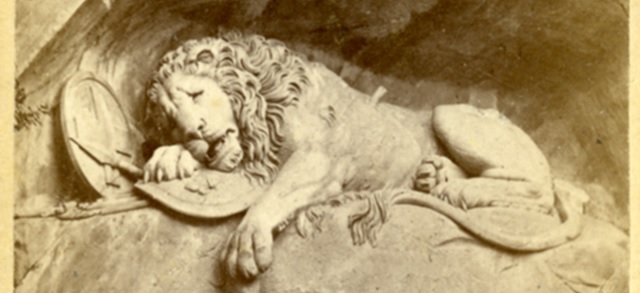
Monuments Class Projects
Architect/Sculptor of Monument
Grinling Gibbons (1741-1848)
Preview

Medium
photograph, carte-de-viste
Keywords
history, William III, equestrian monuments, Ireland, England, Dublin, Equestrian statue of William III, Irish Republican Army, Irish History, Baroque statue, Protestant Ascendancy, removed statues, College Green
Physical Dimensions
3 13/16 x 2 7/16"
Date of Publication
c. 1855-1895
Name of Monument
William III Statue
Date of Creation of Monument
1700
Date of Completion or Dedication of Monument
1701
City of Monument
Dublin
Location within City
College Green
State/Province of Monument
Leinster
Country of Monument
Ireland
Description
This statue of William III once stood in front of the Irish Parliament in College Green, Dublin. It was erected in 1701 by prominent Dublin residents to commemorate the king who set in place the Protestant Ascendancy over Ireland. His pose on horseback reflects his pivotal victory in the Battle of the Boyne (1690). The statue was the target of vandalism by Irish nationalists over the years until it was badly damaged by an Irish Republican bomb in 1929. It was then removed by the Irish Free State government as it moved away from British authority.
School of Art/Architecture
Baroque
Publisher
Unknown
Digital Date
2-7-2025
Copyright
Physical copy of the carte-de-visite is in the public domain. Digital copy scanned by Rod Library © 2025 Rod Library, University of Northern Iowa.
File Format
image/jpeg



Comments
During the reign of William III (1688-1702), wealthy Protestants of Dublin (organized as the Dublin Corporation) paid for this statue to show their support for a king whose reign established a Protestant Ascendancy. The sculptor, Grinling Gibbons, had a history of being the King’s Master Carver under Charles II. It was erected in 1701, the year before William III’s death.
In Ireland, the king was best known for his victory in the Battle of the Boyne (1690), where he defeated his uncle, James II (reigned 1685-1688), who had the support of the Catholic Irish. Irish Protestants favored William and emphasized the religious nature of the conflict. In the end, James was defeated and fled to France, although the Irish population remained mainly Catholic and unrest continued.
The statue itself was a symbol of English and Protestant authority in Dublin, being situated outside the Irish Parliament building (in which only Protestants could serve). It was protected with an iron fence at the outset, and it had an inscription that read: “GULIELMO TERTIO / MAGNÆ BRITANNÆ, FRANCÆ, ET HIBERNTIÆ REGI / OB RELIGIONEM CONSERVATUM / RESTITUTAS LEGES / LIBERTATAM ASSERTAM / CIVES DUBLINIENSIS HANC STATUAM POSSUERE”, which was Latin for: “William the Third, King of Great Britain, France, and Ireland, for the preservation of religion, laws restored and liberty assured, the citizens of Dublin have erected this statue.”
This statue was vandalized numerous times throughout the years, suffering much physical damage that escalated throughout the nineteenth century. After an Irish Republican Army bomb badly damaged the statue in 1929, it was taken down. As the Irish Free State government gained independence from Britain, it removed this and other royal statues which represented English domination over Ireland, including ones of Queen Victoria, George II, and George III.
A modern memorial to Irish nationalist Thomas Davis now stands on the site.